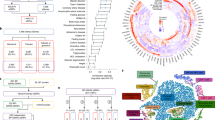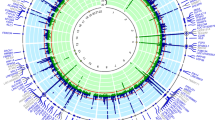Abstract
Human angiotensinogen (AGT) gene promoter polymorphisms (G−217A; A−20C; G−6A) influence AGT transcription in vitro and have been implicated in the genetics of essential hypertension. We analysed the association among AGT promoter variants and AGT mRNA levels in human kidney and visceral adipose tissue (VAT) in vivo. Samples of kidney and VAT were obtained from 35 consecutive patients undergoing renal surgery. The AGT gene promoter of each patient was sequenced to identify variants. AGT gene expression was studied by real-time PCR TaqMan assay. Clinical data obtained before surgery were also considered in the statistical analysis. Two new polymorphisms at −175 and at −163 were identified. Although AGT expression was significantly higher in VAT than in the kidney, when both variants were present together AGT expression in VAT was about fivefold lower (P=0.033) than in the wild haplotype. This lower AGT expression in VAT suggests that the proximity and linkage of −175A and −163A variants might destabilize the binding of specific transcription factors to an acute-phase responsive element 3. Among the known AGT promoter variants, only −20C SNP has an important effect on tissue-specific differential AGT expression in the human tissues studied, inducing a 3.8-fold increase in AGT mRNA localized only in the kidney medulla (P=0.038). The other known polymorphisms (G−6A; G−217A) were not associated with different levels of AGT expression. Our results support the hypothesis that some human AGT promoter variants influence transcriptional activity in a tissue-specific way in humans.
This is a preview of subscription content, access via your institution
Access options
Subscribe to this journal
Receive 12 digital issues and online access to articles
$119.00 per year
only $9.92 per issue
Buy this article
- Purchase on Springer Link
- Instant access to full article PDF
Prices may be subject to local taxes which are calculated during checkout




Similar content being viewed by others
Accession codes
References
Jeunemaitre X, Soubrier F, Kotelevtsev YV, Lifton RP, Williams CS, Charru A et al. Molecular basis of human hypertension: role of angiotensinogen. Cell 1992; 71: 169–180.
Corvol P, Jeunemaitre X . Molecular genetics of human hypertension: role of AGT. Endocr Rev Endocr Rev 1997; 18: 662–677.
Dickson ME, Sigmund CD . Genetic basis of hypertension: revisiting angiotensinogen. Hypertension 2006; 48: 14–20.
Staessen JA, Kuznetsova T, Wang JG, Emelianov D, Vlietinck R, Fagard R . M235T angiotensinogen polymorphism and cardiovascular renal risk. J Hypertens 1999; 17: 9–17.
Inoue I, Nakajima T, Williams CS, Quackenbush J, Puryear R, Powers M et al. A nucleotide substitution in the promoter of human angiotensinogen is associated with essential hypertension and affects basal transcription in vitro. J Clin Invest 1997; 99: 1786–1797.
Sarzani R, Dessì-Fulgheri P, Mazzara D, Catalini R, Cola G, Bersigotti G et al. Cardiovascular phenotype of young adults and angiotensinogen alleles. J Hypertens 2001; 19: 2171–2178.
Pereira TV, Nunes AC, Rudnicki M, Yamada Y, Pereira AC, Krieger JE . Meta-analysis of the association of 4 angiotensinogen polymorphisms with essential hypertension: a role beyond M235T? Hypertension 2008; 51: 778–783.
Jain S, Li Y, Patil S, Kumar A . A single-nucleotide polymorphism in human angiotensinogen gene is associated with essential hypertension and affects glucocorticoid induced promoter activity. J Mol Med 2005; 83: 121–131.
Zhao YY, Zhou J, Narayanan CS, Cui Y, Kumar A . Role of C/A polymorphism at –20 on the expression of human angiotensinogen gene. Hypertension 1999; 33: 108–115.
Dickson ME, Zimmerman MB, Rahmouni K, Sigmund CD . 20 and −217 promoter variants dominate differential angiotensinogen haplotype regulation in angiotensinogen-expressing cells. Hypertension 2007; 49: 631–639.
Cooper R, McFarlane-Anderson N, Bennett FI, Wilks R, Puras A, Tewksbury D et al. ACE, angiotensinogen and obesity: a potential pathway leading to hypertension. J Hum Hypertens 1997; 11: 107–111.
van Harmelen V, Elizalde M, Ariapart P, Bergstedt-Lindqvist S, Reynisdottir S, Hoffstedt J et al. The association of human adipose angiotensinogen gene expression with abdominal fat distribution in obesity. Int J Obes Relat Metab Disord 2000; 24: 673–678.
Rahmouni K, Mark AL, Haynes WG, Sigmund CD . Adipose depot-specific modulation of angiotensinogen gene expression in diet-induced obesity. Am J Physiol Endocrinol Metab 2004; 286: E891–E895.
Ingelfinger JR, Schunkert H, Ellison KE, Pivor M, Zuo WM, Pratt R et al. Intrarenal angiotensinogen: localization and regulation. Pediatr Nephrol 1990; 4: 424–428.
Peti-Peterdi J, Warnock DG, Bell PD . Angiotensin II directly stimulates ENaC activity in the cortical collecting duct via AT1 receptors. J Am Soc Nephrol 2002; 13: 1131–1135.
Sarzani R, Cusi D, Salvi F, Barlassina C, Macciardi F, Pietrucci F et al. The 460Trp allele of alpha-adducin increases carotid intima-media thickness in young adult males. J Hypertens 2006; 24: 697–703.
Sarzani R, Fallo F, Dessi-Fulgheri P, Pistorello M, Lanari A, Paci VM et al. Local renin-angiotensin system in human adrenals and aldosteronomas. Hypertension 1992; 19: 702–707.
Kobori H, Nangaku M, Navar LG, Nishiyama A . The intrarenal renin-angiotensin system: from physiology to the pathobiology of hypertension and kidney disease. Pharmacol Rev 2007; 59: 251–287.
Paul M, Mehr AP, Kreutz R . Physiology of local renin-angiotensin systems. Physiol Rev 2006; 86: 747–803.
Navar LG, Nishiyama A . Why are angiotensin concentrations so high in the kidney? Curr Opin Nephrol Hypertens 2004; 13: 107–115.
Nakajima T, Wooding S, Sakagami T, Emi M, Tokunaga K, Tamiya G et al. Natural selection and population history in the human angiotensinogen gene (AGT): 736 complete AGT sequences in chromosomes from around the world. Am J Hum Genet 2004; 74: 898–916.
Jeunemaitre X, Inoue I, Williams C, Charru A, Tichet JT, Powers M et al. Haplotypes of angiotensinogen in essential hypertension. Am J Hum Genet 1997; 60: 1448–1460.
Sherman CT, Brasier AR . Role of signal transducers and activators of transcription 1 and -3 in inducible regulation of the human angiotensinogen gene by interleukin-6. Mol Endocrinol 2001; 15: 441–457.
Jain S, Shah M, Li Y, Vinukonda G, Sehgal PB, Kumar A . Upregulation of human angiotensinogen (AGT) gene transcription by interferon–gamma: involvement of the STAT1-binding motif in the AGT promoter. Biochim Biophys Acta 2006; 1759: 340–347.
Engeli S, Sharma AM . The renin–angiotensin system and natriuretic peptides in obesity-associated hypertension. J Mol Med 2001; 79: 21–29.
Sarzani R, Salvi F, Dessì-Fulgheri P, Rappelli A . Renin–angiotensin system, natriuretic peptides, obesity, metabolic syndrome, and hypertension: an integrated view in humans. J Hypertens 2008; 26: 831–843.
Saint-Marc P, Kozak LP, Ailhaud G, Darimont C, Negrel R . AngiotensinII asatrophic factor of white adipose tissue: stimulation of adipose cell formation. Endocrinology 2001; 142: 487–492.
Jones BH, Standridge MK, Moustaid N . Angiotensin II increases lipogenesis in 3T3-L1 and human adipose cells. Endocrinology 1997; 138: 1512–1519.
Darimont C, Vassaux G, Ailhaud G, Negrel R . Differentiation of pre-adipose cells: paracrine role of prostacyclin upon stimulation of adipose cells by angiotensin-II. Endocrinology 1994; 135: 2030–2036.
Author information
Authors and Affiliations
Corresponding author
Rights and permissions
About this article
Cite this article
Sarzani, R., Bordicchia, M., Marcucci, P. et al. Angiotensinogen promoter variants influence gene expression in human kidney and visceral adipose tissue. J Hum Hypertens 24, 213–219 (2010). https://doi.org/10.1038/jhh.2009.48
Received:
Revised:
Accepted:
Published:
Issue Date:
DOI: https://doi.org/10.1038/jhh.2009.48
Keywords
This article is cited by
-
The tobacco-specific carcinogen NNK induces pulmonary tumorigenesis via nAChR/Src/STAT3-mediated activation of the renin-angiotensin system and IGF-1R signaling
Experimental & Molecular Medicine (2023)
-
Inflammation, obesity and risk of hypertension: shared pathways or independent risk factors?
Journal of Human Hypertension (2011)



